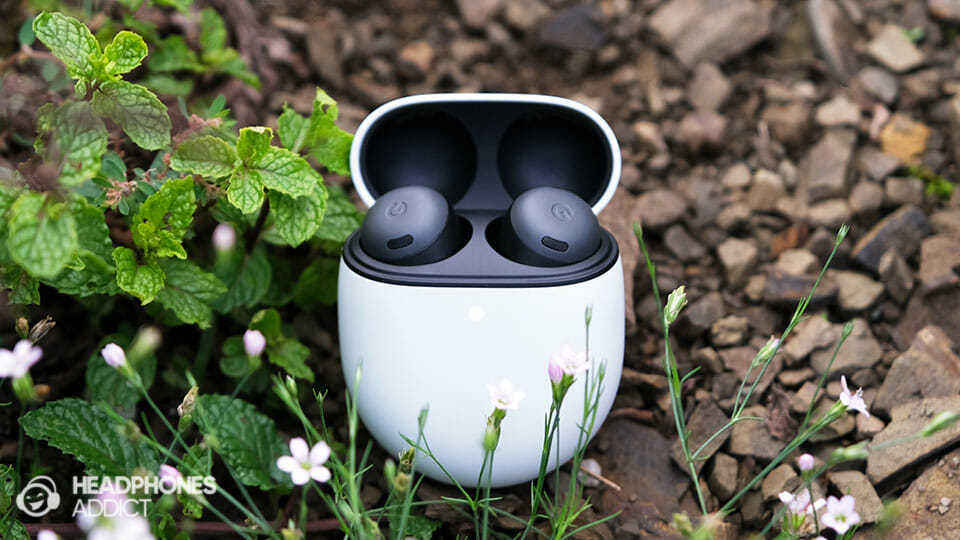
Google Pixel Buds Pro offer everything premium true wireless earbuds should: good ANC, sound, and battery. However, they also come with many compromises, which can be a deal-breaker.
Pixel Buds Pro are the flagship Bluetooth headphones from Google. They have all the features and the build quality you should expect at $200.
You get good active noise-canceling performance, an excellent battery life of almost 8 hours per charge, and a pleasant sound quality (after applying custom EQ).
What are the compromises?
In short: good comfort but bad stability, good sound but mediocre detail, lots of features but poor call quality, reliable Bluetooth but no multipoint (plus more I talk about below).
So should you get them?
We extensively tested and compared them to alternatives. Read the review below to find the results.
UPDATE 11/7/2023: We corrected the statement that the multipoint is missing due to a strange glitch in the app.
Price:
Pros & Cons:
- Great sound, but only after using custom EQ settings
- Long-lasting comfort without pressure sensation
- High battery life of almost 8 hours per charge (with ANC)
- Pretty good active noise cancelling & ambient mode performance
- Sweat resistance on earbuds and charging case
- Mediocre call quality with a noticeable distortion
- No Game mode means distracting latency during gaming
- Inadequate stability makes them unsuitable for sports
Category ratings:
Sound

Google Pixel Buds Pro deliver a boosted bass with natural mids but relatively dark treble. Enabling ANC adds a midrange hump that makes the vocals sound thin. Using a custom EQ is a must if you want a balanced sound.
Hear the difference: The Google Pixel Buds Pro – A/B sound test:
Regardless of the ANC mode, the main sound signature represents a W-shape with a big hump at 5 kHz, which makes guitars a bit shouty and vocals thin, as if the singer has a clogged nose.
Enabling ANC adds another hump at 1.5 kHz, which further hurts the fullness of the vocals. Also, ANC takes away some of the energy from the upper bass and lower mids, making the bass boost more apparent.
These boosts at random frequencies don’t cause a noticeable imbalance at first glance, but a careful A/B comparison reveals inferior vocal and instrument clarity when using noise cancellation.
Applying custom EQ helps a lot, but Google’s implementation of equalizer prevents you from fixing the most significant tuning issues. More on that later.
Google Pixel Buds Pro frequency response

Bass: Boomy but decently controlled
Google Pixel Buds Pro have a good amount of sub-bass. The “boost” gets slightly more exaggerated when enabling ANC, which reduces upper bass and lower midrange.
On its own, the bass seems technically capable and controlled enough for the price. It can play nuances in bass guitars.
However, its performance could be improved by the correct tuning. On many occasions, details in the bass get lost due to the sub-bass boost. It can also make some pop/hip-hop tracks sound bloated.
Setting a custom EQ slightly lowers the sub-bass energy, but you can’t perform miracles.
You’re left with an overall good bass response that could be much better if Google tune it more carefully. It seems like a waste of a fine, custom-made 11mm dynamic driver.

Midrange: Balanced without ANC
As the frequency response graph shows, enabling ANC adds a big hump around 1.5 kHz. I wonder why Google did this since it makes vocals noticeably thin.
You can hear that when listening to “Paint the Town Red” by Doja Cat and switching between ANC off and on.
Furthermore, upper bass and lower midrange have less energy compared to ANC OFF mode, making the sound appear as if you throw a blanket over a speaker.
Disabling ANC immediately reveals slightly more details in instrumentation, especially string instruments. Electric guitars sound angrier and less muddy, like when listening to “Symphony of Destruction” by Megadeth.
Again, turning ANC off and applying our custom EQ provides a very balanced midrange response, albeit that slight dip at 3-4 kHz prevents electric guitars from shining a bit more.

Treble: Good once boosted
On default settings, treble is a mixed bag. You get an unnecessary hump at 5 kHz (also seen in Google Pixel Buds A-Series) and a dull upper treble.
Cymbals have a muted sound, lacking the sizzle and airiness you usually expect. Luckily, our custom equalizer settings should bring the upper treble back to life. You can hear this in “Cake by The Ocean” by DNCE if you toggle between our EQ and Default EQ.
Boosting the upper treble also adds some texture and air, but don’t expect a realistic shimmer and good detail retrieval.
Here’s how our custom EQ sounds next to other EQ presets:
The soundstage is very intimate. Sounds don’t feel trapped in your head, but you can hear singers singing right in front of your face. Width is also narrow, making these earbuds better suited for acoustic and vocal-oriented music.
Furthermore, the imaging is only decently accurate. The center and left/right image are fine, but everything in between gets blurry.
How does that affect sound?
For example, if an instrument is placed right in that blurry spot, you can barely hear it (or it appears unclear).
Nonetheless, these are still some of the better-sounding true wireless earbuds under $200 (as long as you disable ANC and use our custom EQ as the basis).
The issue with a customizable equalizer
Pixel Buds app offer a custom equalizer when paired with Pixel Buds Pro. It is a 5-band equalizer that covers different frequency regions:
| EQ band | Frequency region |
|---|---|
| Lower-bass | 20 Hz-160 Hz |
| Bass | 160 Hz-580 Hz |
| Midrange | 580 Hz-1.9 kHz |
| Treble | 1.9 kHz-9 kHz |
| Upper treble | 9 kHz-19 kHz |
The ability to personalize audio is always welcome, but some implementations are better than others. Google’s is a bit “stiff”.
Basically, when adjusting a band, you raise up and down an entire frequency region as if it is a block, which is best seen when changing the “Treble”. Here’s what we mean by “block”:

As you can see, these regions are in the middle of problematic frequency peaks or dips, preventing you from fixing them.
Google should include at least 4 more bands if you want to correct the earbuds’ sound.
Comfort & Fit

Google Pixel Buds Pro provide exquisite comfort despite their bulky size. On the other hand, they have a rather lackluster stability, making them unsuitable for more intense workouts.
Just like the Pixel Buds A-Series are unique, the Pixel Buds Pro are also different than other earbuds. They’re reminiscent of Samsung Galaxy Buds Live but use ear tips and are bulkier. That said, they are less bulky than JBL Reflect Mini NC or Sony WF-1000XM4.

The earbuds’ shape is simple and tailored for a universal fit. There are no sharp edges or strange curves that would only fit specific users’ ear shape.
That kind of universal fit makes them incredibly comfortable. Never have I experienced wearing fatigue during testing. They feel even better than Pixel Buds A-Series, which are also very comfy.
Furthermore, ear tips don’t go inside your ear canal. Instead, they only block it, which prevents the tips from scratching your skin.
Also, one of the openings on the buds acts as a vent, which releases the air pressure inside your ear canal, further adding to the comfort.

However, mediocre stability is the downside of having a universal fit and no ear wings. While you can safely use them for casual listening at home or during a commute, there are better options for working out.
Earbuds can endure walking around, even outdoors. You might also use them in the gym when lifting weights. In contrast, they could accidentally fall out of your ears when jumping or running.
Durability

Google Pixel Buds Pro have a solid build quality, from earbuds to the case, and offer an IPX4 rating for the buds and IPX2 for the case. That makes them a safe choice for the gym.
Similar to Google Pixel Buds A-Series, the earbuds feel well made. Put together from only 2 parts, they don’t look like you could crack them open without hitting them with a hammer.

Of course, damage to internal components can still occur if you ever drop them, but at least you can rest assured that their exterior is built like a tank.
On the flip side, they’re only water-resistant and not waterproof. Having an IPX4 rating means that you can sweat in them or use them outdoors during light rain. Anything more than that could be an issue.
Interestingly, their charging case has an IPX2 rating, which is relatively low (tested against water droplets, not splashes of water). However, charging cases with an IPX rating are rare. So that’s always nice to see.

Combining both IP ratings means you can safely use them in the gym and store the case in the same bag as your sweaty clothes.
As for the build quality of the case, it is built slightly better than the one on the Pixel Buds A-Series. You get a tougher hinge, but you should still avoid applying too much force on it.
Battery

Google Pixel Buds Pro have a battery life of 7 hours and 52 minutes, almost an hour more than advertised. Also, you get support for Qi wireless and fast charging, although the latter could be faster.
Google Pixel Buds Pro Battery Comparison

Like the Pixel Buds A-Series, the Pixel Buds Pro exceed the official battery life expectancy. In our test, we let earbuds play music at 50% volume (with ANC enabled). Here are the results:
- 7 hours and 52 minutes of music playtime on a single charge.
Google states the earbuds last up to seven hours per charge, almost an hour less than what you actually get (I’m not sure at what volume Google made the test).
The latter is especially important because Google Pixel Buds Pro aren’t the loudest earbuds out there. Pushing them to 60% volume finally brings them to a casual listening volume.

The charging case holds another 13 hours of charge, which is low considering its size and weight. Disabling ANC pushes runtime up to 11 hours per charge, with another 20 hours in the case.
Nonetheless, at least it supports Qi wireless charging and fast charging:
- A 5-minute charge adds another hour of playtime.
Note that these are the first true wireless earbuds we’ve tested that don’t come with a charging cable. Most users won’t mind this as you can charge the Buds case with a smartphone’s cable. The only ones that might be affected are Apple users with incompatible cables.
Features

Google Pixel Buds Pro have a bunch of neat features, but only some are worth using. And, the microphone quality could be much better, given the $200 price tag.
Premium price also means extra features. The most notable ones are Active Noise Control, but there’s much more hidden in the Pixel Buds app.
- Custom equalizer with presets
- Volume balance
- Mono audio
- Volume EQ
- Touch controls
- Ear tip seal check
- In-ear detection
- Find device
- Multipoint

Custom equalizer with presets
We’ve already touched on the custom equalizer and how it works above. But to recap, it’s good that you use it, as it helps improve the sound. However, it’s flawed, so you can only partially fix the tuning issues.
You get a 5-band custom EQ and 6 EQ presets:
- Default
- Heavy bass
- Light bass
- Balanced
- Vocal clarity
- Clarity
- Last saved (your custom settings)

Inside the equalizer, you also get the Volume EQ feature, which raises the bass and treble frequencies when listening at lower volumes. However, the result is a somewhat boomy sound, so we don’t recommend using it.
Interestingly, you don’t get the Adaptive Sound feature like in the Google Pixel Buds A-Series, which adjusts the volume based on the loudness of the external noise.
Volume balance & mono audio
Volume balance feature is helpful for people with worse hearing in one ear, but the same feature is available in most smartphone settings.
Furthermore, the Mono audio feature is helpful if you plan to share one earbud with someone else and don’t have an extra pair of headphones.
Touch controls
Pixel Buds Pro have limited customization of controls: You can add the “OFF” option in ANC mode, and select whether you want to summon Google Assistant from the left or right earbud.

Other commands are fixed and unchangeable. But at least you get volume control, which is lacking in the A-Series buds. Here are the Pixel Buds Pro controls:
| Gesture | Action |
|---|---|
| Single tap | Play/pause/answer call |
| Double tap | Next track/reject call |
| Triple tap | Previous track |
| Press & hold | Change ANC mode/ summon smart assistant |
| Swipe forward | Volume up |
| Swipe backward | Volume down |
One thing worth mentioning is that all settings, from controls to audio, get stored in the earbuds. So, your custom settings work regardless of which device you connect the earbuds to.

Spatial Audio & Head-Tracking
Google Pixel Buds Pro also have the support for head tracking and Spatial Audio feature, which is built into Android 13 and above.
Unfortunately, I use a Samsung phone, which has this feature locked away, so you can only use it on Samsung Galaxy Buds. Therefore, I sadly couldn’t evaluate the features’ performance.
- To access Spatial Audio, you must go into the Bluetooth settings of the Pixel Buds Pro and enable it there.
- Then, you must find the supported content to enjoy spatial effects in all its glory.
Microphone quality
Google Pixel Buds Pro have disappointing call quality. They make your voice sound thin and distorted if the ambient noise gets loud.
Here’s the mic test.
Google Pixel Buds Pro microphone test: (no noise test from 0:00-0:34, with background noise test from O:34-0:58)
Even in ideal environments, like a quiet room, earbuds capture a tiny portion of frequencies essential to understanding human speech.
The result is a thin voice lacking lower frequencies. Others can still understand what you say, but your voice sounds unnatural.
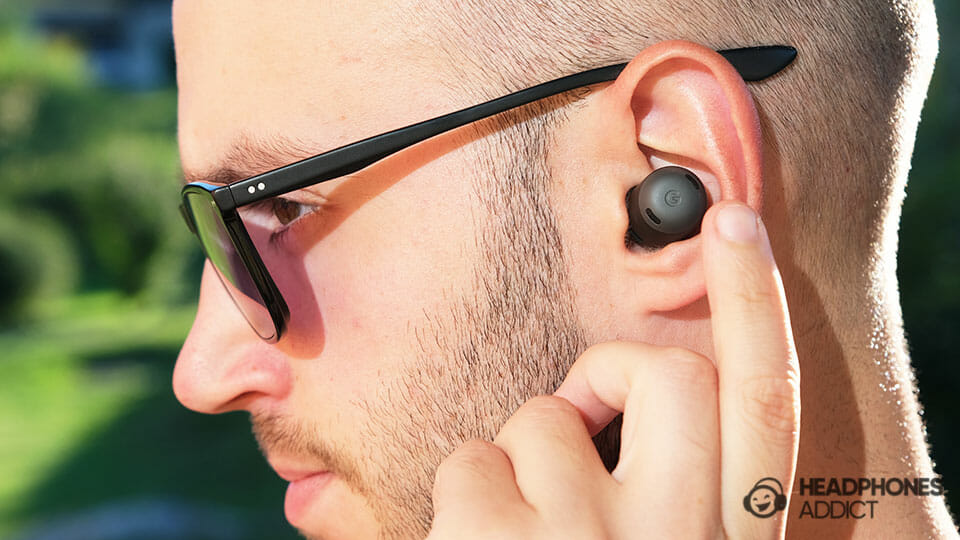
Voice quality degrades noticeably when exposing the mics to louder environmental noise, like busy traffic. The aggressive noise suppression struggles to keep the traffic silent but fundamentally hurts the voice clarity and adds distortion.
Honestly, I expected more from premium earbuds like Google Pixel Buds Pro. For the price, their mic quality should at least match the Pixel Buds A-Series. However, the latter actually perform better for making phone calls.
Noise Isolation

Google Pixel Buds Pro have really good passive noise isolation that can block a good portion of high-frequency noise and even a bit of upper bass and midrange frequencies. But you need an ANC for a well-rounded experience.
The unconventional shape of the Pixel Buds Pro nicely “fills all the cracks” and blocks a good chunk of outside noise from entering your ear canal.
Here’s a chart showing the effectiveness of Pixel Buds Pro passive noise isolation:

Earbuds isolate the most at around 4 kHz and from 9 kHz and above. As expected, low frequencies remain almost intact, so you can still hear the engine rumble loud and clear. In that case, using ANC is a must.
Since Buds Pro’s tips only rest in front of the canal, their performance is more than surprising. For example, Google Pixel Buds A-Series have a much worse isolation.
Noise Cancelling

Google Pixel Buds Pro do exceptionally well at reducing lower frequencies while letting through a bit more of the higher ones. Still, they’re a reliable pick for commuters and travelers.
Google Pixel Buds Pro active noise cancelling test:
Pixel Buds Pro are Google’s first attempt at making noise-cancelling earbuds, and they’re in for a good start.
Earbuds work remarkably well at cancelling out lower frequencies, especially between 100 Hz and 500 Hz.

They reduce frequencies between 20 Hz and 90 Hz a bit less, so you might still hear a bit of engine rumble, but only when you aren’t playing music.
Reduction in higher frequencies is also good, but because there’s a worse performance at 950 Hz, you might still hear some of the human chatter. So, playing music while using ANC is a must to entirely block everything.
What about ambient sound mode?
Ambient sound mode naturally boosts noise up to about 700 Hz, after which you get a significant hump between 700 Hz and 3 kHz.
While that clears up and brings human voices up front, it also makes them thin-sounding. Nevertheless, that means you don’t need to take off your earbuds while talking to someone next to you.

Bluetooth

Google Pixel Buds Pro have an average indoor Bluetooth range of 40 feet but an overall stable connection. While watching videos is lag-free, playing games reveals a noticeable latency.
Pixel Buds Pro are pretty average regarding Bluetooth connectivity. You get an older Bluetooth 5.0, which is good but less resistant against interferences from nearby wireless devices.

The close-range connection proves to be stable without random hiccups. Long-range indoor connection showed a rather average performance, lasting up until:
- 40 feet (or 12.2 meters), after which the audio started to stutter. We could still reach the 50-foot mark, but due to the stutters, the audio becomes unlistenable.
How to pair Google Pixel Buds Pro?
- Opening the charging case for the first time, the pairing process initiates automatically. You can pair them via Bluetooth settings or wait for the Google Fast Pair pop-up window to appear and connect the earbuds to your Android account.
- To pair the earbuds to a different device, you first place them in the case and hold the button on the back of the case. You should see the white LED in front of the case start blinking.

Google Pixel Buds Pro also support Bluetooth multipoint. It enables you to connect the buds to two devices simultaneously and change the audio source by simply pressing “play” on a device you’re currently working on.
Since audio settings are stored in the buds and work using different devices, they make a great multitasking tool.
However, it does have some limitations. For example, you need to pause the audio on one device before moving to the other. Pressing “play” on one device doesn’t automatically pause the audio on the other.
Unless both devices run Android and are signed into the same Google account, in that case, you can fix the play/pause limitation by switching on the Audio switch.

Furthermore, if you don’t see the “multipoint” toggle in the Pixel app, try reinstalling it. We encountered that exact glitch, so we first thought that the feature was absent.

What Bluetooth codecs do they use?
Google Pixel Buds Pro use a standard set of SBC and AAC Bluetooth codecs.
With that, they cover both iOS and Android users, even though Android devices use AAC by default, despite being less optimized for using that over SBC.
Is there an audio lag?
There’s no visible audio lag when watching videos on streaming apps and social media. That works on both operating systems.
On the other hand, there’s a significant latency when playing mobile games. Since there’s no Game mode to reduce the latency, it’s hard to recommend Pixel Buds Pro for competitive gamers.
Forcing earbuds to use SBC instead of AAC helps a little, but not enough to make the lag tolerable.
Should You Buy Google Pixel Buds Pro?

Google Pixel Buds Pro are a mix of many compromises. You have the comfort but not a stable fit, you get many features but poor call quality, you get a great sound but only when turning ANC off, and so on.
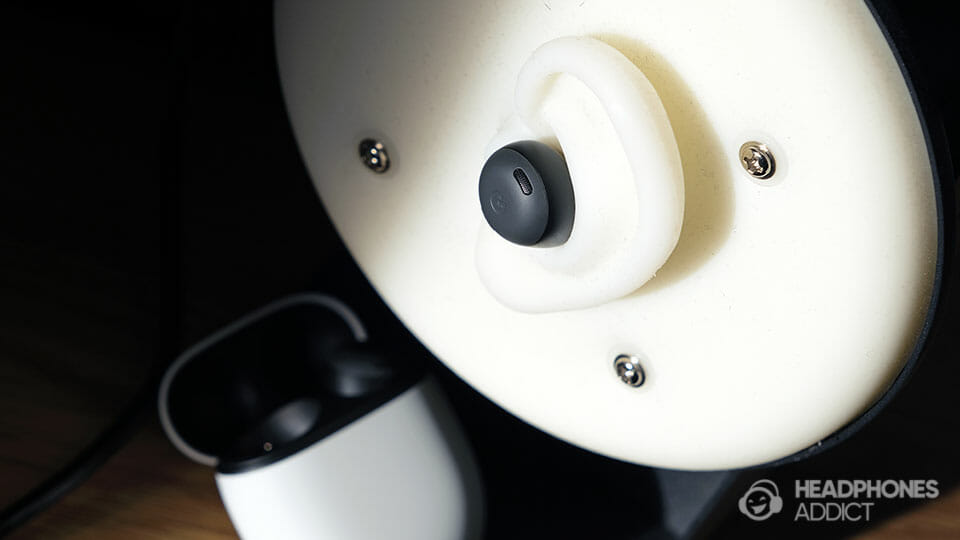
We only recommend these earbuds to:
- Commuters: Thanks to good active noise cancellation and transparency mode performance, comfort and satisfying sound quality.
- Students: Due to good ANC, comfort, and long battery life.
- Gym-goers: Thanks to an IPX rating on earbuds and the charging case, but only for LIGHT workouts due to inadequate stability.
On the other hand, we don’t recommend these earbuds to:
- Audio purists: While you can make the sound fairly natural, you can’t eliminate the 5 kHz peak and sub-bass boost.
- Office workers: Due to poor call quality and ANC, which could be more effective against human speech.
How do Google Pixel Buds Pro compare to the competition?
- Pixel Buds Pro have among the most pleasant audio out of all TWS earbuds under $200 (after EQ).
- Earbuds also exceed in comfort, which matches the best in this price range.
- Google Buds are near the top for the longest-lasting battery life of almost 8 hours per charge (with ANC).
- They offer to store settings on the buds, whereas most earbuds don’t have that option.
- Their active noise cancelling and ambient mode performance are about on par with the competition.
- Pixel Buds Pro have a subpar call quality, unsuitable for earbuds of such caliber.
- Due to poor stability, they’re less suitable for sports activities than competitors.
- They lack Game mode and Bluetooth multipoint, often seen in wireless earbuds in this price range, at least the latter.
Google Pixel Buds Pro alternatives
Sony WF-1000XM4
Due to a price drop, you can get much more balanced-sounding earbuds with better detail retrieval for a lower price. They also stick to your ears more due to hybrid foam eartips.
Moreover, you get a more even ANC performance and more natural ambient sound mode. However, you can expect a slightly worse battery life and comfort (they’re massive).
TOZO Golden X1
Sound quality is about equal, but the sound signature is very different. TOZO’s earbuds are more bright and less smooth than Pixel Pro’s.
Otherwise, TOZO’s are slightly more stable and durable thanks to an IPX6 and a more rigid-looking housing. However, they are less effective with ANC and ambient sound mode.
What’s in the Box?

- Google Pixel Buds Pro true wireless earbuds
- Charging case
- 3 pairs of silicone ear tips (S, M, L)
- User manual
Specifications
| Type: | True wireless |
| Connection: | Bluetooth 5.0 |
| Back design: | Closed-back |
| Drivers: | 11mm dynamic |
| Frequency range: | n/a |
| Impedance: | n/a |
| Weight: | 0.22 ounces (6.2 grams) per earbud |
| Mic & Controls: | Yes |
| Water resistance: | IPX4 (buds) & IPX2 (case) |
| Battery life: | 7.5h + 13h in case |
| Charging time: | Quick charge – USB-C & Qi wireless charging |
| Active noise cancelling: | Yes |
| Bluetooth codecs: | SBC, AAC |
| Wireless range: | 40 feet (or 12.2 meters) |
| Microphone: | 3 beamforming mics (with a wind-blocking mesh) |

From a childhood fascination with sound, Peter’s passion has evolved into a relentless pursuit of the finest headphones. He’s an audio expert with over 5 years of experience in testing both audiophile and consumer-grade headphones. Quote: “After many years, I can confidently tell which headphones are good and which are terrible.” Find his honest opinion in his reviews.








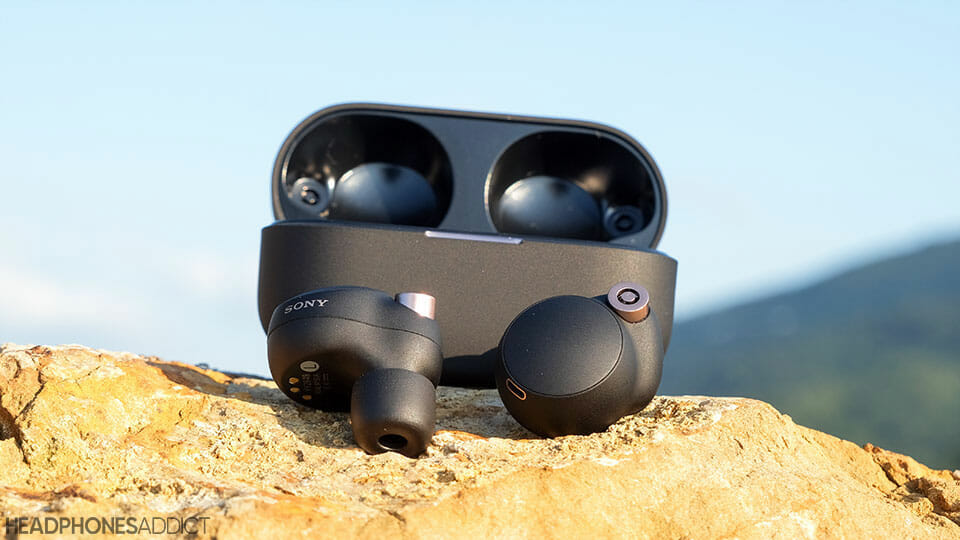
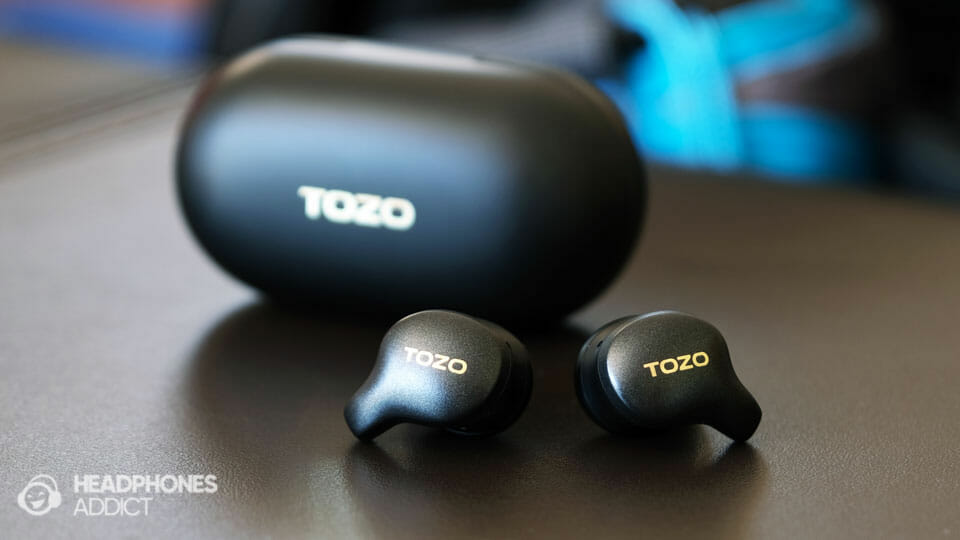


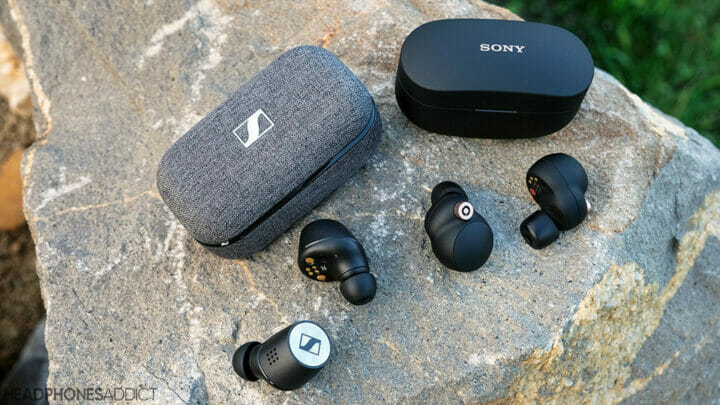
4 Comments
Adam
Will you test new Bose headphones?
Matija Ferjan
Probably 😀
Carlos Tejeda
The Pixel Buds Pro does have multipoint and it works pretty well, at least for me (switch between Pixel 6a and Windows 11 laptop) . Not sure why the review says it doesn’t.
https://support.google.com/googlepixelbuds/answer/12319417?hl=en
Peter Susic
Hello, Carlos!
you’re right; Google Pixel Buds Pro DO support multipoint. We installed the app again and saw that the feature is accessible through the app or Bluetooth menu. Upon further inspection of the screenshots made during our review, we see that the feature wasn’t available in the app, which is why we stated that the earbuds don’t have it. This is highly odd. We probably got a glitch.
Thank you for correcting us. We’ll correct the review immediately 😉